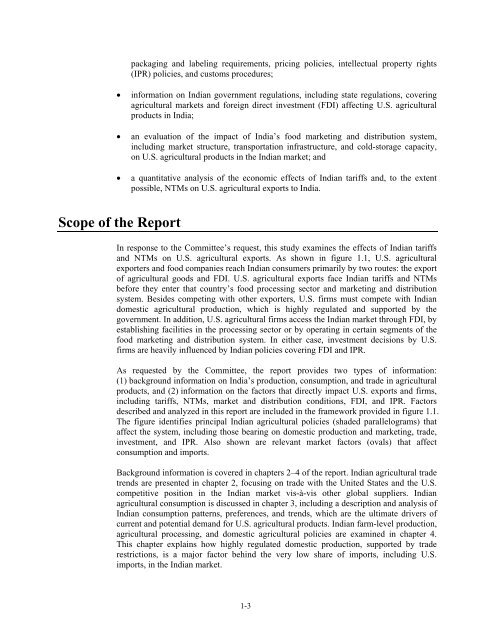India: Effects of Tariffs and Nontariff Measures on U.S. ... - USITC
India: Effects of Tariffs and Nontariff Measures on U.S. ... - USITC
India: Effects of Tariffs and Nontariff Measures on U.S. ... - USITC
Create successful ePaper yourself
Turn your PDF publications into a flip-book with our unique Google optimized e-Paper software.
packaging <str<strong>on</strong>g>and</str<strong>on</strong>g> labeling requirements, pricing policies, intellectual property rights<br />
(IPR) policies, <str<strong>on</strong>g>and</str<strong>on</strong>g> customs procedures;<br />
<br />
<br />
<br />
informati<strong>on</strong> <strong>on</strong> <str<strong>on</strong>g>India</str<strong>on</strong>g>n government regulati<strong>on</strong>s, including state regulati<strong>on</strong>s, covering<br />
agricultural markets <str<strong>on</strong>g>and</str<strong>on</strong>g> foreign direct investment (FDI) affecting U.S. agricultural<br />
products in <str<strong>on</strong>g>India</str<strong>on</strong>g>;<br />
an evaluati<strong>on</strong> <str<strong>on</strong>g>of</str<strong>on</strong>g> the impact <str<strong>on</strong>g>of</str<strong>on</strong>g> <str<strong>on</strong>g>India</str<strong>on</strong>g>’s food marketing <str<strong>on</strong>g>and</str<strong>on</strong>g> distributi<strong>on</strong> system,<br />
including market structure, transportati<strong>on</strong> infrastructure, <str<strong>on</strong>g>and</str<strong>on</strong>g> cold-storage capacity,<br />
<strong>on</strong> U.S. agricultural products in the <str<strong>on</strong>g>India</str<strong>on</strong>g>n market; <str<strong>on</strong>g>and</str<strong>on</strong>g><br />
a quantitative analysis <str<strong>on</strong>g>of</str<strong>on</strong>g> the ec<strong>on</strong>omic effects <str<strong>on</strong>g>of</str<strong>on</strong>g> <str<strong>on</strong>g>India</str<strong>on</strong>g>n tariffs <str<strong>on</strong>g>and</str<strong>on</strong>g>, to the extent<br />
possible, NTMs <strong>on</strong> U.S. agricultural exports to <str<strong>on</strong>g>India</str<strong>on</strong>g>.<br />
Scope <str<strong>on</strong>g>of</str<strong>on</strong>g> the Report<br />
In resp<strong>on</strong>se to the Committee’s request, this study examines the effects <str<strong>on</strong>g>of</str<strong>on</strong>g> <str<strong>on</strong>g>India</str<strong>on</strong>g>n tariffs<br />
<str<strong>on</strong>g>and</str<strong>on</strong>g> NTMs <strong>on</strong> U.S. agricultural exports. As shown in figure 1.1, U.S. agricultural<br />
exporters <str<strong>on</strong>g>and</str<strong>on</strong>g> food companies reach <str<strong>on</strong>g>India</str<strong>on</strong>g>n c<strong>on</strong>sumers primarily by two routes: the export<br />
<str<strong>on</strong>g>of</str<strong>on</strong>g> agricultural goods <str<strong>on</strong>g>and</str<strong>on</strong>g> FDI. U.S. agricultural exports face <str<strong>on</strong>g>India</str<strong>on</strong>g>n tariffs <str<strong>on</strong>g>and</str<strong>on</strong>g> NTMs<br />
before they enter that country’s food processing sector <str<strong>on</strong>g>and</str<strong>on</strong>g> marketing <str<strong>on</strong>g>and</str<strong>on</strong>g> distributi<strong>on</strong><br />
system. Besides competing with other exporters, U.S. firms must compete with <str<strong>on</strong>g>India</str<strong>on</strong>g>n<br />
domestic agricultural producti<strong>on</strong>, which is highly regulated <str<strong>on</strong>g>and</str<strong>on</strong>g> supported by the<br />
government. In additi<strong>on</strong>, U.S. agricultural firms access the <str<strong>on</strong>g>India</str<strong>on</strong>g>n market through FDI, by<br />
establishing facilities in the processing sector or by operating in certain segments <str<strong>on</strong>g>of</str<strong>on</strong>g> the<br />
food marketing <str<strong>on</strong>g>and</str<strong>on</strong>g> distributi<strong>on</strong> system. In either case, investment decisi<strong>on</strong>s by U.S.<br />
firms are heavily influenced by <str<strong>on</strong>g>India</str<strong>on</strong>g>n policies covering FDI <str<strong>on</strong>g>and</str<strong>on</strong>g> IPR.<br />
As requested by the Committee, the report provides two types <str<strong>on</strong>g>of</str<strong>on</strong>g> informati<strong>on</strong>:<br />
(1) background informati<strong>on</strong> <strong>on</strong> <str<strong>on</strong>g>India</str<strong>on</strong>g>’s producti<strong>on</strong>, c<strong>on</strong>sumpti<strong>on</strong>, <str<strong>on</strong>g>and</str<strong>on</strong>g> trade in agricultural<br />
products, <str<strong>on</strong>g>and</str<strong>on</strong>g> (2) informati<strong>on</strong> <strong>on</strong> the factors that directly impact U.S. exports <str<strong>on</strong>g>and</str<strong>on</strong>g> firms,<br />
including tariffs, NTMs, market <str<strong>on</strong>g>and</str<strong>on</strong>g> distributi<strong>on</strong> c<strong>on</strong>diti<strong>on</strong>s, FDI, <str<strong>on</strong>g>and</str<strong>on</strong>g> IPR. Factors<br />
described <str<strong>on</strong>g>and</str<strong>on</strong>g> analyzed in this report are included in the framework provided in figure 1.1.<br />
The figure identifies principal <str<strong>on</strong>g>India</str<strong>on</strong>g>n agricultural policies (shaded parallelograms) that<br />
affect the system, including those bearing <strong>on</strong> domestic producti<strong>on</strong> <str<strong>on</strong>g>and</str<strong>on</strong>g> marketing, trade,<br />
investment, <str<strong>on</strong>g>and</str<strong>on</strong>g> IPR. Also shown are relevant market factors (ovals) that affect<br />
c<strong>on</strong>sumpti<strong>on</strong> <str<strong>on</strong>g>and</str<strong>on</strong>g> imports.<br />
Background informati<strong>on</strong> is covered in chapters 2–4 <str<strong>on</strong>g>of</str<strong>on</strong>g> the report. <str<strong>on</strong>g>India</str<strong>on</strong>g>n agricultural trade<br />
trends are presented in chapter 2, focusing <strong>on</strong> trade with the United States <str<strong>on</strong>g>and</str<strong>on</strong>g> the U.S.<br />
competitive positi<strong>on</strong> in the <str<strong>on</strong>g>India</str<strong>on</strong>g>n market vis-à-vis other global suppliers. <str<strong>on</strong>g>India</str<strong>on</strong>g>n<br />
agricultural c<strong>on</strong>sumpti<strong>on</strong> is discussed in chapter 3, including a descripti<strong>on</strong> <str<strong>on</strong>g>and</str<strong>on</strong>g> analysis <str<strong>on</strong>g>of</str<strong>on</strong>g><br />
<str<strong>on</strong>g>India</str<strong>on</strong>g>n c<strong>on</strong>sumpti<strong>on</strong> patterns, preferences, <str<strong>on</strong>g>and</str<strong>on</strong>g> trends, which are the ultimate drivers <str<strong>on</strong>g>of</str<strong>on</strong>g><br />
current <str<strong>on</strong>g>and</str<strong>on</strong>g> potential dem<str<strong>on</strong>g>and</str<strong>on</strong>g> for U.S. agricultural products. <str<strong>on</strong>g>India</str<strong>on</strong>g>n farm-level producti<strong>on</strong>,<br />
agricultural processing, <str<strong>on</strong>g>and</str<strong>on</strong>g> domestic agricultural policies are examined in chapter 4.<br />
This chapter explains how highly regulated domestic producti<strong>on</strong>, supported by trade<br />
restricti<strong>on</strong>s, is a major factor behind the very low share <str<strong>on</strong>g>of</str<strong>on</strong>g> imports, including U.S.<br />
imports, in the <str<strong>on</strong>g>India</str<strong>on</strong>g>n market.<br />
1-3

















